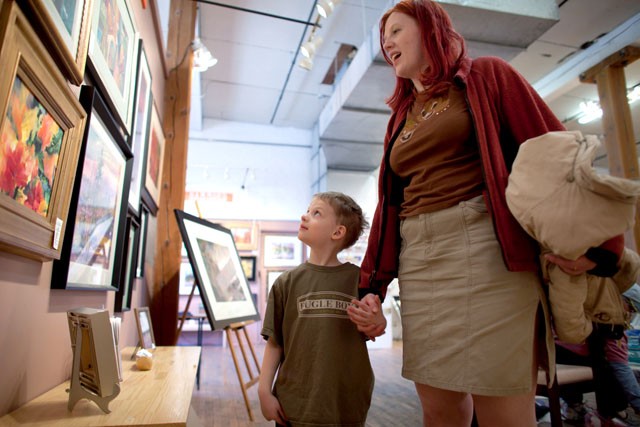As he drove around Northeast Minneapolis with his pregnant wife, Michael Rainville wondered if starting his family there made him a bad husband.
At the time, in 1995, the cityâÄôs all-time high of 99 murders had earned it the nickname âÄúMurderapolis.âÄù
Through the window of his car, Rainville suddenly saw a 300-pound man âÄúknocking the hellâÄù out of a police officer. As he pulled over to help, his wife turned to him.
âÄúNo,âÄù she said. âÄúWeâÄôre going home.
âÄúAnd weâÄôre going to [find] a house in the suburbs.âÄù
Rainville, a fifth-generation resident of Northeast, stopped the car and helped the officer. He and his family decided to stay.
Since then, Minneapolis has lost its damning nickname, and Northeast in particular has seen
significant growth. According to Rainville, the artists in the community can be thanked for that.
âÄúThe arts community stabilized the area,âÄù Rainville said. âÄúI saw this tired blue-collar neighborhood on the way down come around.âÄù
Originally the neighborhood was full of functional factories and the workersâÄô families, but as those factories became abandoned in the 1980s, the families moved on too, leaving more room for crime.
But with low rent and warehouses open for studio space, a common phenomenon happenedâÄîartists moved in and revitalized the industrial neighborhood, said University of Minnesota urban studies professor Brenda Kayzar.
Studios opened up, people began to move back and soon small businesses started to repopulate the streets.
But with this kind of trend comes a sad ending. As property values increase with new growth, artists eventually get pushed out with higher rent prices.
To prevent this from happening, as it already did in the cityâÄôs Warehouse District, the artists formed an association and strategic plan in 2002 to prevent the gentrification.
The Northeast Minneapolis Arts District and its street banners were established to promote awareness of the artistsâÄô economic value, like how they bring in new residents and businesses. The Art-a-Whirl event, for example, brings in up to 50,000 visitors a year, Kayzar said.
But with a lack of funding from the city, the plan hasnâÄôt been fully utilized, Kayzar said. Low-income housing for artists has been hard to finance, and many building owners havenâÄôt promised to keep rent low or offer opportunities for artists to own their studios.
With the economic downturn and poor housing market, artists have bought more time in the neighborhood, but some still canâÄôt imagine Minneapolis protecting the arts district after the recession eases.
âÄúIt happens to every single art community that ever existed,âÄù said artist Calvin deRuyter, who works out of the Northrup King Building in Northeast. âÄúWhy would we be any different?âÄù
DeRuyter said he has high hopes but predicted the community will need to find a new home in 10 or 15 years.
Increasing safety
âÄúWhen you mention the Northeast, there are still people in the Cities who practically turn pale in the face from fear,âÄù deRuyter said with a chuckle. âÄú[But] I think artists have made a big stride in pulling people into the community and saying itâÄôs safe here.âÄù
Danielle Nelson and her 6-year-old son Leif said they feel safe in the area and enjoy spending days exploring the arts district thatâÄôs in their own backyard.
âÄúI love my neighborhood,âÄù Nelson said of the community sheâÄôs lived in for 15 years.
However, down Jackson Street in the residential neighborhood near the arts district, some struggle to embrace that sense of security.
âÄúI never feel completely at ease here,âÄù homeowner Melissa Boeser said.
SheâÄôs been awakened by neighbors on several late nights, including a time when one reported her roommate had a knife and was threatening to kill her.
But Boeser said she has seen efforts to improve the area, particularly with the art culture she gets the chance to experience.
âÄúI donâÄôt think weâÄôd ever move from here,âÄù she said as she prepared to paint her house. âÄúSeems strange that IâÄôm saying that, but I donâÄôt think we would.âÄù
Fears for the future
While artists have outlined their hopes in the Art Action plan, residents have their own set of concerns about the future of Northeast.
Boeser said she would like to see less garbage around the neighborhood, and another neighbor said there needs to be more community outreach.
âÄúThere havenâÄôt been as many changes as I wouldâÄôve liked,âÄù said Boeser, who would like landlords to fix up neighboring houses.
She said the problem is due to both funding issues and a lack of motivation by community members, but hopes the attention provided by the arts community will bring more inspiration.
While Boeser and the arts community has made commitments to the area, Marvina Hayes, who lives across the street from Boeser, said she didnâÄôt see how the artists were making much of a difference. In fact, Hayes said she is moving from the area in hopes of finding better opportunities for her family.
âÄúIâÄôve been here for four years,âÄù the single mother of three said in front of a pickup truck loaded with mattresses and kids toys. âÄúI need a change.âÄù
Perry Ingli, an active member of the Northeast arts community, countered that the arts community has made a difference, bringing new life and business to the area.
âÄúIf all the artists were to leave here, the Northeast would feel it,âÄù Ingli said. âÄúWhen you go out in the suburbs, itâÄôs boring as hell. ThereâÄôs no culture there.âÄù

Image by Anthony Kwan
Lief Nelson looks at paintings with her mom Danielle Nelson Saturday at the Northrop King Building in Northeast Minneapolis.
Life intersects art in Northeast
In Northeast Minneapolis, artists moved in and revitalized the industrial neighborhood, but they may soon be pushed out by rising rent prices.
Published April 4, 2011
0
More to Discover







